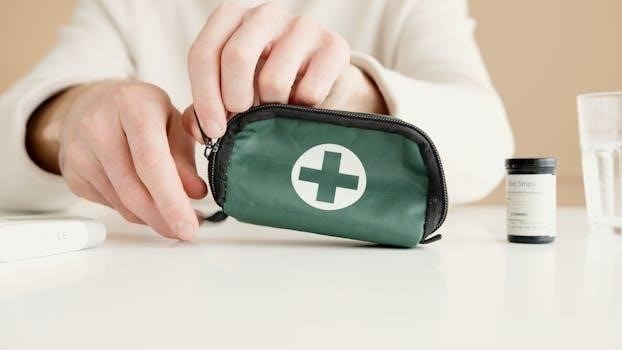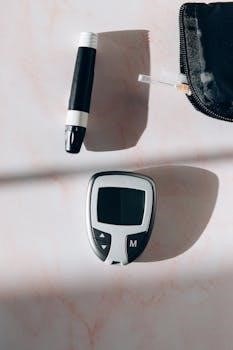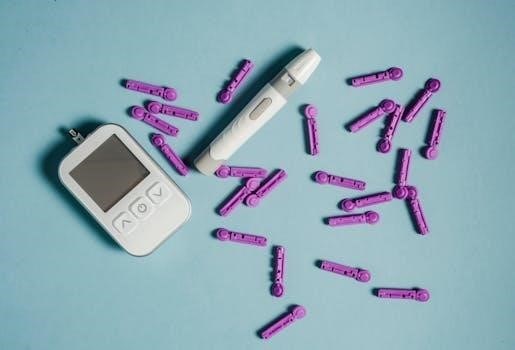Pool test kits are essential tools for maintaining safe and balanced pool water. These kits come in various forms, from digital analyzers to reagent-based systems and test strips, each designed for easy at-home chemical checks. They ensure proper water chemistry to kill bacteria.
Importance of Regular Pool Testing
Regular pool testing is crucial for maintaining a healthy and safe swimming environment. Consistent monitoring of chemical levels, such as pH, chlorine, and total alkalinity, helps prevent the growth of harmful bacteria and algae. Proper testing ensures that your pool water is balanced, protecting swimmers from skin and eye irritation, and the pool equipment from corrosion and damage. Following a regular testing routine also helps you to optimize chemical usage, saving money and resources, and ensuring clear water.
Types of Pool Test Kits
Pool test kits vary, including digital analyzers that send results to your phone, reagent-based kits using liquid chemicals, and simple test strips. Each type offers different methods for measuring chemical levels in pool water.
Digital Water Analyzers
Digital water analyzers are a modern approach to pool testing, offering convenience and accuracy. These devices often monitor chemical levels in real-time and transmit the results directly to a smartphone app. This technology allows for easy tracking and adjustments to pool chemistry, simplifying maintenance. Digital analyzers are favored for their user-friendliness and precise measurements, making pool care more efficient and less hands-on than manual methods, such as reagent-based kits or test strips.
Reagent-Based Test Kits
Reagent-based test kits are a traditional method for assessing pool water chemistry. They involve adding specific liquid reagents to a water sample and comparing the resulting color to a chart. These kits typically measure parameters like pH, chlorine, and alkalinity. Each test has different reagent amounts and color results, requiring careful reading of the instructions. While requiring a bit more manual effort, they offer a reliable means of testing for various chemical parameters, and are usually more precise than test strips.
Test Strips
Test strips offer a quick and convenient way to assess pool water balance. These strips contain chemical pads that react with the water, changing color to indicate the levels of different parameters like pH, chlorine, and total alkalinity. To use a test strip you just dip it into the pool water, remove it, and compare the resulting pad colors to the chart provided by the manufacturer; While they are fast and easy, they may not be as accurate as reagent-based or digital kits.
Key Parameters Tested
Pool test kits measure several critical parameters, including pH, chlorine or bromine levels, total alkalinity, and cyanuric acid (CYA). These readings help maintain clear, safe, and healthy swimming pool water.
pH Level
Testing the pH level is crucial for maintaining balanced pool water, generally aiming for a range of 6.8-7.2. Proper pH levels ensure chlorine’s effectiveness and prevent damage to pool surfaces and equipment. A pH test helps you determine if your pool water is too acidic or too alkaline, guiding the necessary chemical adjustments to protect your pool and swimmers.
Chlorine/Bromine Level
Maintaining proper chlorine or bromine levels is vital for sanitizing pool water, killing harmful bacteria and preventing algae growth. The ideal range depends on your pool’s CYA level, so it’s essential to test regularly. Test kits measure free chlorine, the active sanitizing form, ensuring your pool water remains safe for swimming. Knowing your free chlorine levels is key for a healthy pool.
Total Alkalinity
Total alkalinity (TA) acts as a buffer, preventing drastic pH fluctuations in pool water. Maintaining proper TA is essential for stable water chemistry. Test kits help measure TA levels, allowing you to adjust chemicals as needed. This ensures that the pH remains within the ideal range, contributing to comfortable and safe swimming conditions. It’s important for preventing corrosion and scaling.
Cyanuric Acid (CYA) Level
Cyanuric acid, also known as stabilizer, protects chlorine from sunlight’s degradation. Maintaining the correct CYA level is essential for effective chlorination. Pool test kits include CYA tests, often involving a specialized mixing bottle. CYA levels influence the amount of chlorine needed. Following specific test kit instructions for CYA testing is critical to determine optimal chlorine levels, ensuring a safe and sanitized pool environment for swimming.

Using a Pool Test Kit
Using a pool test kit involves several steps⁚ carefully following instructions, taking a water sample, and then reading the results, often by comparing colors on a chart. Every kit is slightly different so always follow its specific guide.
Following Instructions
Before using any pool test kit, it is crucial to thoroughly read the included manual for specific tips and guidelines. Each kit, whether digital or manual, has unique procedures for accurate testing. Different tests have varied reagent amounts and color results. Always follow the manufacturer’s instructions, which may be found online, or within the physical kit. Understanding each step ensures the most reliable water analysis.
Taking a Water Sample
Properly collecting a water sample is vital for accurate testing. For the best results, sample the water from elbow depth. Be sure to rinse the comparator tubes several times with the pool water before filling them. When using a sample line, attach it to the controller. Fill sample containers to the line, ensuring the correct amount of water is used for the test. Avoid surface water, which is not a representative sample.
Reading Color Charts
Many pool test kits utilize color charts to determine chemical levels. After adding reagents to your water sample, compare the resulting color to the chart provided. Different tests will produce different colors. Ensure you are using the correct chart for each specific test. Note that color interpretation can be subjective, and it might take practice to get the hang of it. Always perform tests under good lighting for accurate readings.

Recording and Monitoring Results
Keeping a record of your pool test results is crucial for monitoring chemical trends. Use a notebook, spreadsheet, or app to track data. This helps understand how your pool responds to treatments.
Importance of Keeping Records
Maintaining detailed records of your pool’s chemical test results is vital for long-term pool health. By logging each test, whether you use a notebook, spreadsheet, or dedicated app, you gain the ability to monitor trends. This historical data helps you anticipate changes in your pool’s chemistry, allowing for proactive adjustments, and it provides a better understanding of how the pool responds to different treatments and environmental factors, ensuring consistent water quality and safety, and this helps you maintain optimal water quality.
Advanced Testing Methods
For more precise analysis, consider professional testing at pool supply stores. These services provide detailed water analysis, often using specialized equipment, offering an alternative to home testing for a more thorough result.
Professional Testing at Supply Stores
Pool supply stores offer advanced testing services using sophisticated equipment, providing a comprehensive analysis of your pool water. This method is beneficial for obtaining a detailed breakdown of chemical levels beyond what standard home kits can offer. Experts at these stores can help interpret results and recommend specific treatments, ensuring optimal water balance and safety. It’s a useful resource for complex issues or if you’re seeking highly accurate readings.
Digital vs. Manual Test Kits
Digital test kits offer convenient, direct readings, often connecting to smartphones, while manual kits, like reagent-based systems, require visual color matching. Each type has pros and cons regarding ease of use and accuracy.
Pros and Cons of Each
Digital kits offer quick, precise results sent to a phone, reducing the chance of human error, but they can be more expensive and require batteries. Manual kits are cheaper, but rely on user interpretation of color charts, which can be subjective. Reagent-based kits involve more steps, while strips offer convenience but may be less accurate. Each type has benefits and drawbacks for different users.

Specific Test Kit Instructions
Each test kit has unique instructions, often found online, or in the user manual. These instructions may include specific reagent amounts, and details on how to read the results. Always follow them closely.
CYA Test Instructions
The Cyanuric Acid (CYA) test is crucial for determining optimal free chlorine levels. To perform this test, fill the red-capped mixing bottle to the bottom line with pool water. The instructions may vary by brand, so refer to your specific test kit manual or online resources for detailed steps. After testing, use the CYA reading to determine the correct free chlorine levels. This test might be subjective, so practice can improve accuracy. Always use the user manual!

Maintenance and Troubleshooting
Rinsing comparator tubes is important for accurate readings. Always rinse them several times with sample water after each test. This prevents chemical buildup and ensures the best results for future tests.
Rinsing Comparator Tubes
Properly rinsing comparator tubes is crucial for maintaining the accuracy of your pool test kit. After each test, thoroughly rinse the tubes with the pool water to remove any residual chemicals or reagents. This practice will help prevent cross-contamination and ensure that future readings are not affected by previous tests. Use the sample line or water from elbow depth directly from the pool to rinse the tubes. Repeat rinsing several times, making sure the tubes are clean before the next use. This simple step greatly improves the reliability of your test results.
Maintaining optimal water quality is essential for safe and enjoyable pool use. Regular testing using your pool test kit, along with proper maintenance practices, helps achieve this, ensuring a healthy swimming environment.
Maintaining Optimal Water Quality
Achieving and maintaining optimal pool water quality is paramount for swimmer safety and enjoyment. Regular testing, using a reliable kit, such as those provided by HTH, is crucial. By consistently monitoring chemical levels like chlorine, pH and CYA, you can ensure a clean and healthy pool environment. Remember, optimal free chlorine levels depend on your CYA levels and balanced water chemistry is essential to kill bacteria, providing a safe swimming experience.